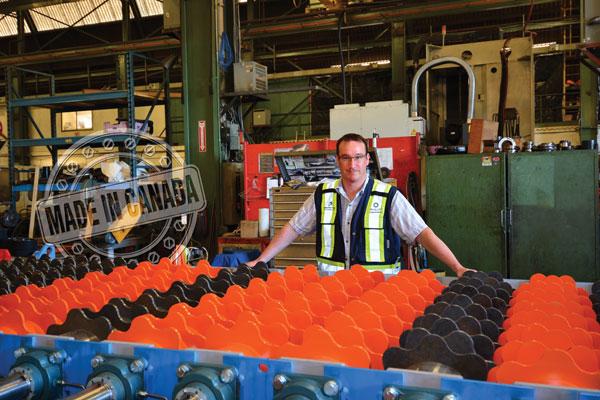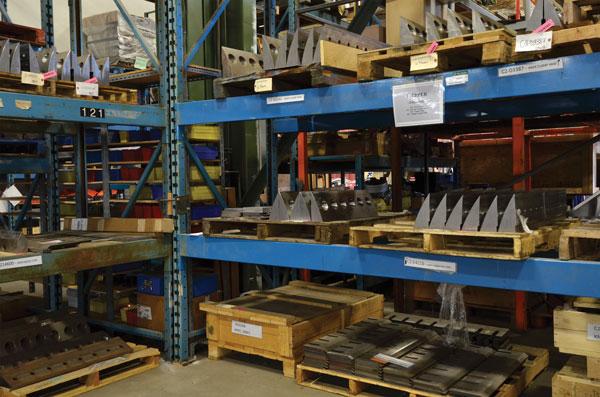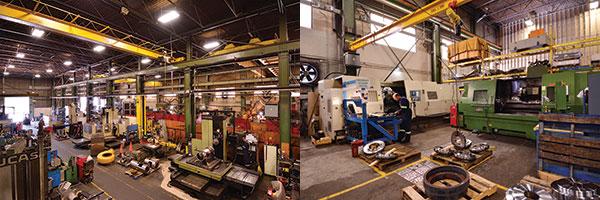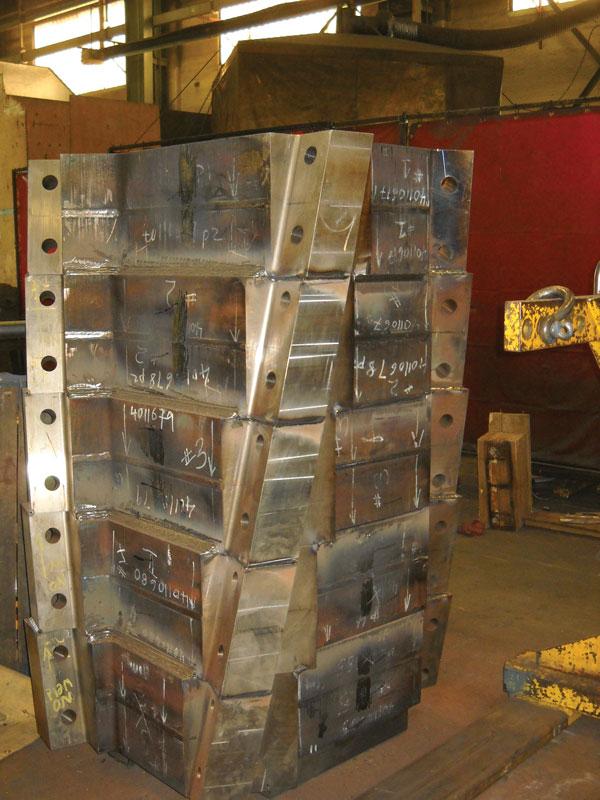- FMA
- The Fabricator
- FABTECH
- Canadian Metalworking
Chipping Away at Wood Waste
Brunette Machinery processing equipment adds value to reject material
- By Sue Roberts
- December 5, 2014
- Article
- Made In Canada

Kirk Forbes, president of Brunette Machinery, Surrey, B.C., paused by a disc scalping screen, a new offering for the company. As ground wood waste moves over the rolls, fine material falls through into bins to prevent regrinding; larger material is moved on to the discs.
A family sits down to a food-laden dining table. A grandparent dozes in a worn rocking chair. A white-washed picket fence surrounds a home. A chef dices vegetables on a cutting board. An invitation is penned on beautiful parchment. A crew builds the frame for a new home. Products crafted from the beauty and strength of wood surround us.
Today’s logging and sawmilling industries work to fulfill market needs in an environmentally conscious manner, reforesting to ensure future supplies. Wood waste, the byproduct of transforming trees into lumber, joins recycled wood from landfills, contractors, construction companies, and tree service providers to become a significant biomass component, reducing landfill and contributing to power generation. Cleaning and grinding turns the waste into usable material.
From its headquarters in Surrey, B.C., Brunette Machinery Co. designs and builds hogs to grind waste for biomass recovery systems, debarkers, chippers, and vibrating conveyors. For the last two years the equipment, designed and marketed by Brunette, has been built by its partner Murray Latta Progressive Machine Inc. Colocated in a 60,000-sq.-ft. facility, the two companies bring nearly 200 years of experience into the process.
Successful Combination
Brunette Machinery President Kirk Forbes has a past with both companies. While an engineering student he worked at Murray Latta through a co-op program, where he got to know the owners and the company’s capabilities. Ten years ago he became part of the Brunette team. He was serving as general manager when owner Per Brunes, and Forbes’ mentor, decided to retire in 2013.
“We worked out an arrangement so I could buy the business,” said Forbes. “Murray Latta came to mind even though I hadn’t been in touch with the company since college. I presented them with the idea of becoming partners, and we ended up married pretty quickly. We purchased the assets of Brunette Industries Ltd. in New Westminster; Brunette Industries Ltd. in Prince George; Brunette Industries Inc. in Atlanta, Ga.; and BDR Machinery Ltd. in Toronto.” All branches now operate under the Brunette Machinery name.
Brunette claims about 22 employees including the staff in the Toronto office and the Prince George shop that provides general machining and repair services to several industries, including logging and sawmilling, biomass, mining, and oil and gas. Over 100 Murray Latta shop employees produce the Brunette equipment as part of their responsibilities. Murray Latta is a full-service job shop with CNC and conventional machining, metal fabricating, and welding. It also provides millwrighting and machine installations and moves.
Some administrative operations are shared to create efficiencies. One accounting department, for example, maintains and manages the accounts of both companies. And for the sales teams the line between the Brunette and Murray Latta products is blurring.
“We’re working on cross-training the sales staff. In some cases, we are visiting the same places and we want to be as efficient as possible. We want everyone to know that when we are visiting mills we can talk about planers and installation on the Murray Latta side and chippers and hogs on the Brunette side,” Forbes said.
Equipment to Fit the Customer
Although North America is the company’s “bread basket,” Brunette equipment is cleaning, sorting, and grinding in plants in South Africa, England, Scotland, Uruguay, and Australia. “We don’t have branches in those areas, but the mills come to us because of our name and reputation,” said Forbes.
The Brunette sales process typically involves a substantial amount of back-and-forth communications and strategic planning with the customers. The desired end product is the starting point to determine the best equipment for the job.
“We actually bring in a customer’s product and classify it. Then we ask the customer what he wants the material to look like after it has been processed. We do some test processing to determine what equipment will do the job and make a recommendation. Then we determine the size and configuration of the equipment for the individual plant.
“We don’t try to make a customer’s operation fit our equipment. With our SmartVIBE conveyors, for example, we have a set build formula, but we re-engineer to make sure we provide exactly what the customer needs. For the most part, our equipment is made to spec with a turnaround of about three months,” Forbes said.
A key advantage to the vibrating conveyor, in addition to being built to fit the length and width of an operation, is the variable-speed drive (VSD). The VSD allows operators to use the controls to increase or decrease the conveying speed while remaining completely balanced without shutting down.
Shared Philosophies and Work Flow
On the Murray Latta shop floor, Brunette contributes to the work load that keeps two shifts busy and frequently under a crunch to get deliveries out on time. When a Brunette machine is sold, a purchase order is generated for Murry Latta. Then the equipment is built with involvement from both companies.
The pairing works for both companies. “What Murray Latta does well is to continually invest in the machinery they have—both the machining and fabricating equipment. Like us, they are always looking for ways to stay current and diversify,” Forbes said.
“Our whole-log chippers are some of the heaviest equipment in the industry,” said Forbes. “They have a 5-ft.-diameter rotor and 40-in.-wide knives rotating at about 250 RPM. They have a very robust frame, shaft, and bearings. We design and build our equipment to handle the worst possible scenarios.”
Designing During the Downturn

Replacement parts and critical components for building Brunette equipment are warehoused for quick response. Components that comprise equipment frames and boxes are produced just-in-time.
“The lumber industry is closely tied to the U.S. housing market,” said Forbes. “When the housing starts were dropping in 2008, the company was embarked on an aggressive R&D program. We developed the vibrating conveyor; the BioSizer®, which is a high-speed secondary grinder for the woody biomass industry; the whole-log chipper to produce microchips; and a chipper designed to process veneer residuals. We had other chippers in our product line, but we were able to utilize our industry experience and adapted existing technology.”
The addition of the whole-log machine to the product line of chippers positioned the company as the place to go for chipping the long and short of wood waste. Short materials are fed into the drop feed drum chipper, where the customer can choose the resulting chip size. The full length of single-piece, tapered knives processes the material, providing efficiency, even wear, and increased blade life. A high-inertia rotor processes high volumes with efficient energy use. The anvil is designed to swing away in case of metal contamination.
The whole-log chipper has a modular design and can be installed with an infeed conveyor, chipper drive motor, and hydraulic power unit positioned on a frame that allows the system to be containerized for international shipments. Top and bottom hydraulic-driven feed rolls move logs of any species into the chipper. The rotor uses either four or eight knives, customer’s choice, to turn a complete log into pulp or microchips.
During the same timeframe the company developed a veneer chipper with enough size, power, and versatility to replace multiple chippers within a facility. Residual materials—reject veneer, cores, and spinouts—are reduced to quality chips.
Expanding the Product Line
All but two Brunette products have been designed and engineered inhouse. Those two exceptions offer the same quality and heavy-duty construction as the Brunette line and mesh well with the goal of efficiency and productivity.
Continental Biomass Industries Inc. (CBI), with headquarters in New Hampshire, owns the rights to the Grizzly Mill product line. Brunette manufactures and distributes several models known to have large shafts and bearings to support high-horsepower drives for processing largediameter material.
“We have worked very closely with CBI as their only licensed manufacturer and distributor for over 20 years now,” said Forbes. “It’s the No. 1 sawmill and wood processing hog in North America.”
The second product that didn’t grow out of a Brunette design carries the company name—Brunette E-Sweeps. Working like a pinball paddle, these sweeps kick logs off of a conveyor and onto a transfer deck, basically changing the direction of the log. The “E” stands for electric, which is the product’s differentiating factor.
“Traditionally the sweeps would be pneumatic or hydraulic. With air, compressors would run all day long, and you could potentially have air leaks. With hydraulics you have a power unit running all day, wasting electricity, and there might be oil leaks that can be an environmental concern especially in outside installations,” said Forbes. “Our electric sweeps with variable-speed drives consume energy only when they kick a log. They are very energy-efficient. Mills in states with energy efficiency programs are now finding they can qualify for energy rebate programs with the local electric companies.

Large, heavy, and detailed components for Brunette equipment are machined on Murray Latta CNC mills, turning, and boring equipment.
“The fabricator that designed the product is a company we regularly work with when we do larger turnkey projects. We saw that he had something different than what was available in the market and, most importantly, that he shared our philosophy— put the customer first, build it with quality, and build it right. We put together a marketing and distribution agreement and have never looked back.”
Brunette is entrenched in the forestry industry but poised to provide its products beyond the timberline. It is adapting its wood waste processing experience to the biomass industry with the BioSizer product line, and stainless steel versions of Brunette’s SmartVIBE conveyors may soon find their way into the food processing industry.
Diversification and growth in New Westminster, B.C.: Get ready Murray Latta. There might be a third shift in the future.
subscribe now


Keep up to date with the latest news, events, and technology for all things metal from our pair of monthly magazines written specifically for Canadian manufacturers!
Start Your Free Subscription- Trending Articles
- Industry Events
ZEISS Quality Innovation Days 2024
- April 15 - 19, 2024
Tube 2024
- April 15 - 19, 2024
- Düsseldorf, Germany
Lincoln Electric's Large Format 3D Metal Printing Seminar
- April 16 - 17, 2024
- Cleveland, OH
CTMA Economic Uncertainty: Helping You Navigate Windsor Seminar
- April 30, 2024
- Windsor, ON Canada
MME Winnipeg
- April 30, 2024
- Winnipeg, ON Canada
















